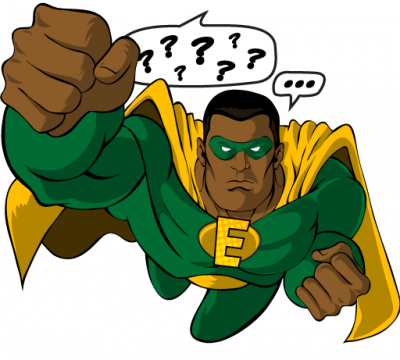Ask the Superexpert about Electricity & Energy Efficiency
Have you ever wondered why shoes hanging on a power line don’t get fried? Or whether cars could someday run on cow manure? Now you can get answers to these and all your energy-related questions. Just Ask the Superexpert!
The Superexpert answers new questions regularly, so check back to see if YOUR question is up!
Shoes hanging on a power line don’t get burned for the same reason that birds standing on a power line don’t get shocked: they don’t give electricity a path to the ground, so electricity stays in the line and does not go through them. But if the shoes were to touch a power line and a power pole at the same time, they would provide a path to the ground and would get blasted with electric current. It wouldn’t be pretty!
By the way, if you ever see someone throwing shoes up onto a line, tell them to stop! The shoes can damage the power line, or someone trying to get the shoes down could be seriously shocked or even killed.
Yes! An electric eel uses chemicals in its body to manufacture electricity. A large electric eel can produce a charge of up to 650 volts, which is more than five times the shocking power of a household outlet.
Yes! Manure can be made into a gas containing methane. (Methane is the same energy-rich gas found in natural gas.) Certain types of bacteria emit this gas as they consume manure collected in special air-free tanks. The mixture of gases produced in this way, called biogas, can then be used in some modified car engines instead of gasoline, or burned in a boiler to generate heat or electricity.
Since turning on a light is such a simple thing to do, I think you must be asking about the “work” of the electrical transmission and distribution system, which brings electricity from the power plant to the light bulbs in your home or school. This system does indeed involve a lot of work! To learn more about it, check out the Travels of Electricity section of our website.
Organic waste emits methane as it decomposes—or rots—in the landfill. Landfills can collect and treat the methane and then sell it as a commercial fuel, or they can burn it to generate steam and electricity. Today, there are almost 915 gas energy landfill projects operating in the United States.
Technically, windmills do not create electricity, but wind turbines do. Windmills have been in use for about 1,200 years. They use the wind’s energy to do mechanical work, such as milling grain or pumping water. Wind turbines operate differently than windmills. Rather than using the wind’s energy for mechanical work, they use the power of the wind to spin a turbine generator and produce electricity. As the wind blows, it turns the blades of the turbine, which spins a magnet near a coil of copper wire. The spinning magnet causes the electrons in the coil of wire to move. This generates electricity, which is sent through power lines to where it is needed.
One lightning strike can carry 100 million to 1 billion volts. That’s the equivalent of between 8 and 80 million car batteries!”
Replacing your five most frequently used light fixtures or the bulbs in them with ENERGY STAR certified lights can save $70 a year in energy costs.
(Source: Energy Star)
Ben Franklin probably did not do his famous kite experiment the way it is usually portrayed. (Franklin never wrote about it himself, and the only description we have of it was written by another scholar, Joseph Priestley, 15 years later.) Franklin believed lightning was a flow of electricity taking place in nature. He knew of electricity’s dangers, and would probably not have risked being struck by lightning by flying his kite during a storm. It is more likely that Franklin flew his kite before the storm occurred, and that his famous key gave off an electric spark by drawing small electrical charges from the air.
Although Americans make up only about 4 percent of the world’s population, we use about 17 percent of the world’s energy! And we consume about 12 times more energy per person than people in Mexico, and almost 7 times more energy than people in Canada.

